How do you make your outdoor space more awesome than usual? With a hexagonal fire pit swing. This structure creates a warm comfortable spot where you can entertain guests.
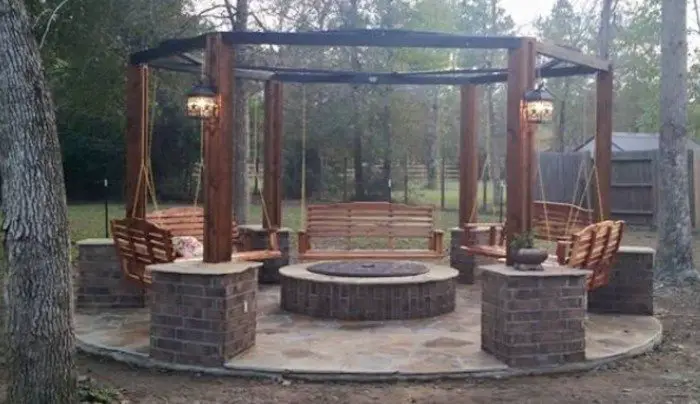
Contents
Hexagonal Fire Pit Swing: The Ultimate Backyard Upgrade
This hexagonal swing has a beautiful roof design that makes it look like a pergola. It has unique seating which is made from wagon wheels purchased by the owner-builder from Tractor Supply.
It’s easy to maintain as well as convenient to use since it was built with a concrete platform that includes a drainage for the fire pit. This keeps the hexagon fire pit swing set dry most of the time and ready to use even right after some rain.
This take on the hexagonal swing with a fire pit is a step higher than most designs out there!
How about you? How would you design your DIY outdoor furniture to make it awesome?
Click on any image to start the lightbox display. Use your Esc key to close the lightbox.![]()
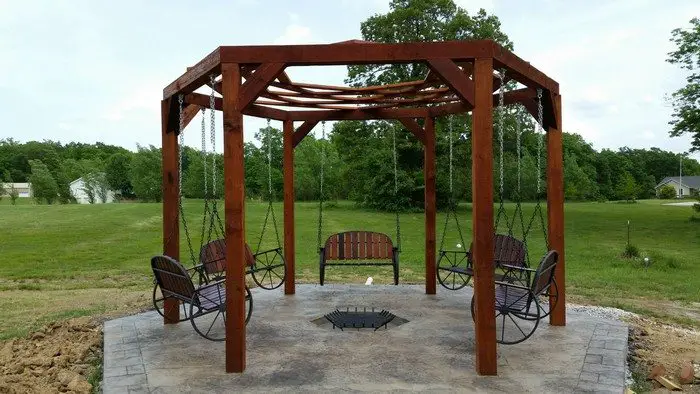
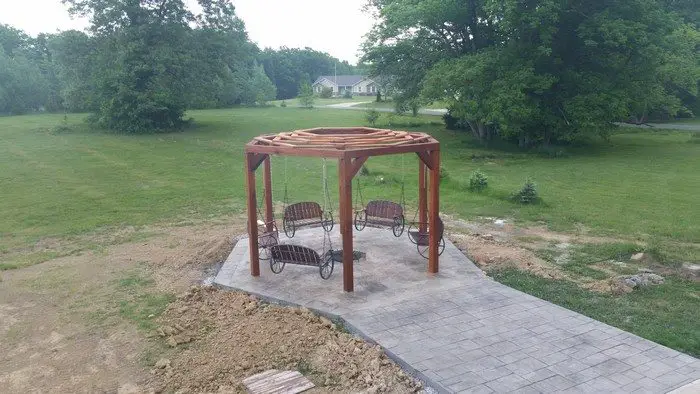
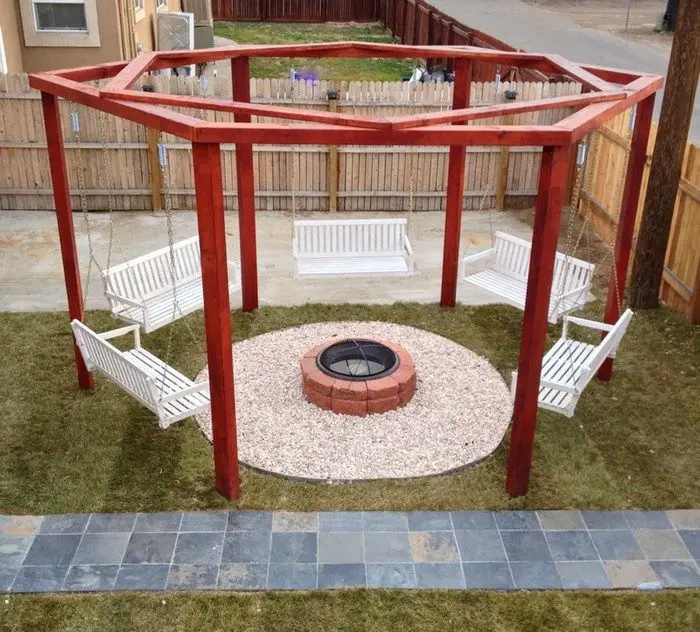
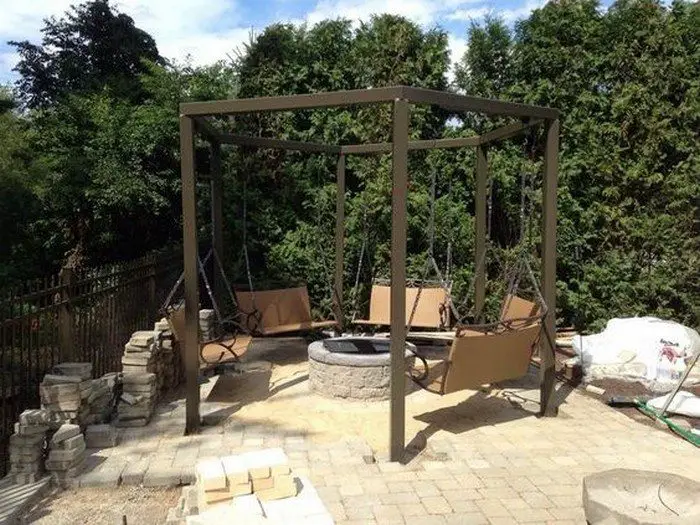


Building Your Hexagonal Fire Pit Swing
Before starting this DIY outdoor upgrade project, it is essential to gather all the necessary materials and tools in order to streamline the process and prevent the need for multiple trips due to missing items.
Materials:
- 6 x 6 x 10 Timber (for structural posts)
- 2 x 6 x 8 Timber (for seating or support beams)
- Wagon Wheels (decorative and functional accents)
- TimberLOK Heavy-Duty Wood Screws (for durable fastening)
- 4″ PVC with Cast Iron (for drainage or structural base, clarify intended use)
- Hexagonal 36″ Grate (for the fire pit)
- Wood Sealer (to protect the timber from weathering)
- Concrete (for setting the posts securely in the ground)
- Gravel or Crushed Stone (for drainage and to level the area)
- Sand (to create a stable base under the fire pit)
- Metal Fire Ring (optional, to line the fire pit for safety and longevity)
- Stain or Paint (optional, for aesthetic purposes on wood)
- Hanging Chains or Rope (if the swing seats will be suspended)
- Swing Seat Hardware (such as eye bolts, hooks, or swing hangers)
- Fire-Resistant Stones or Bricks (for constructing the fire pit border)
Tools:
- Hammer (for general use or additional nail support)
- Shovel (for digging post holes and leveling the ground)
- Measuring Tape (for precise measurements)
- Miter Saw (for cutting timber at angles)
- Cordless Drill (for screws and hardware installation)
- Mallet (for tapping pieces into place without damaging them)
- Ladder (for assembling overhead structures)
- Level (to ensure posts and beams are straight and even)
- Post Hole Digger (to create deep, uniform holes for the posts)
- Power Sander or Sanding Block (to smooth rough edges on the wood)
- Socket Wrench Set (for tightening bolts and hardware)
- Circular Saw (optional, for larger or straight cuts)
- Work Gloves (to protect your hands)
- Safety Goggles (to protect your eyes during cutting and drilling)
- Clamps (to hold timber securely while cutting or drilling)
- Bucket or Wheelbarrow (for mixing and transporting concrete)
Instructions
Here’s a detailed, beginner-friendly explanation of the steps to help you successfully build your hexagonal fire pit swing.
1. Prepare the Site
- Clear the Area: Use a shovel to remove grass, weeds, and debris from the area where you’ll build. Aim for a flat surface.
- Level the Ground: Use a rake or the back of your shovel to make the area smooth. You can check the flatness with a level or a straight piece of wood.
- Mark the Center: Use a measuring tape to find the exact center of the cleared area. Place a small stake or marker at the center to guide your fire pit placement.
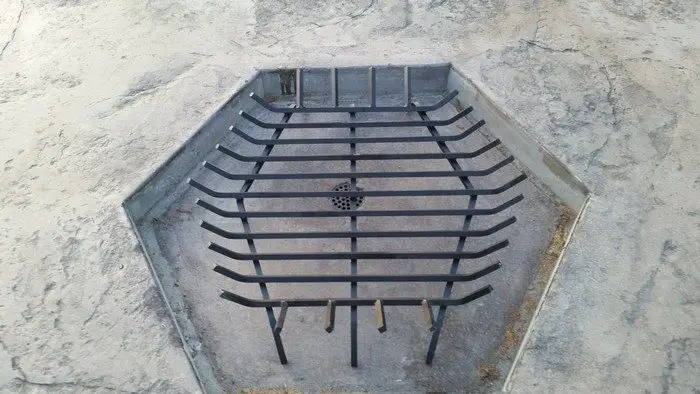
2. Construct the Fire Pit
- Dig the Hole:
- At the marked center, dig a hole slightly wider than your hexagonal grate (about 2-3 inches larger on each side).
- The depth should be around 8-10 inches, depending on how flush you want the grate with the ground.
- Add Drainage
- Place the 4″ PVC pipe with cast iron in the middle of the hole to act as a drainage system. Ensure it stands upright and is firmly in place.
- Build the Base:
- Lay your 6 x 6 x 10 timber around the PVC pipe in a hexagonal shape to form the fire pit’s base.
- Use TimberLOK heavy-duty screws to secure the timbers together. Drill each screw in at an angle for a snug fit.
- If using fire-resistant stones or bricks, you can line the inside of the pit for added durability and safety.
3. Build the Hexagonal Frame
- Cut the Frame Pieces:
- Use a miter saw to cut the 2 x 6 x 8 timber into six equal pieces.
- Make sure each end has a 30-degree angle so they fit together seamlessly.
- Double-check measurements to avoid gaps in the frame.
- Assemble the Frame:
- Lay the cut pieces on the ground around the fire pit, forming a hexagon shape.
- Secure the corners with TimberLOK screws, ensuring all sides are tightly fastened and even.
4. Erect the Vertical Posts
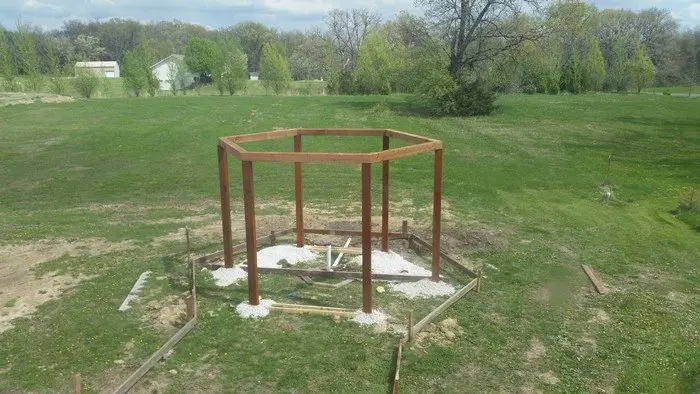
- Cut the Posts:
- Position the 6 x 6 x 10 timber into six equal lengths from the fire pit for the vertical posts. These will support the swings.
- Position the Posts:
- Place each post at the corners of the hexagon frame.
- Use a level to ensure the posts are perfectly upright. This step is critical for stability.
- Secure the Posts:
- Drive TimberLOK screws through the bottom of each post into the hexagonal frame. You can also use concrete around the base of each post for added stability.
5. Attach the Wagon Wheels
- Position the Wagon Wheels:
- Attach a wagon wheel on each side of the swing seat. These will act as support for the swing seats.
- Secure the Wheels:
- Use a cordless drill and screws to firmly attach the wheels. Ensure they are level and can support weight without tilting.
6. Install the Swing Seats
- Attach the Chains or Ropes:
- Use heavy-duty chains or weather-resistant ropes to hang the swing seats. Attach them securely to the wagon wheels using swing hangers or hooks.
- Make sure each chain is the same length to ensure even seating.
- Hang the Seats:
- Hook the swing seats onto wagon wheels. Test each swing to ensure it moves smoothly and is securely attached.

7. Apply Wood Sealer
- Protect the Timber:
- Use a brush or roller to apply wood sealer to all exposed wood surfaces. This helps prevent weather damage and prolongs the structure’s lifespan.
- Follow the manufacturer’s instructions for drying time and additional coats.
8. Perform Final Checks
- Inspect the Structure:
- Go around the entire project and check for any loose screws, uneven posts, or misaligned parts. Tighten screws and adjust where necessary.
- Test Stability:
- Gently pull on the posts and sit on the swings to ensure everything is stable and secure.
- Test the Fire Pit:
- Light a small fire in the pit to ensure it’s safe and functional. Check the drainage to make sure water doesn’t collect in the pit.
By following these steps, you’ll create sturdy and functional hexagonal swings around fire pit that are perfect for outdoor gatherings. Take your time with each step, and don’t hesitate to ask for help if you need an extra pair of hands!
Safety Considerations for Hexagonal Fire Pit Swings
Building an outdoor upgrade is an exciting project. However, safety is paramount. This guide outlines key safety considerations to ensure its usage both enjoyable and secure.
Fire Safety
When building and enjoying a hexagonal fire pit swing, fire safety must be a top priority. The swing’s close proximity to the fire pit requires careful consideration of several factors to ensure everyone’s safety.
Use of Non-Flammable Materials
Select materials that are highly resistant to fire for the swing’s construction. This is particularly crucial for parts of the swing that are nearest to the fire pit. Opt for metals or treated woods that have a high fire resistance rating. Avoid using plastics or other materials that can easily melt or ignite.
Maintaining a Safe Distance
It’s essential to establish a safe distance between the fire pit and the swing. This distance should be enough to prevent sparks or flames from reaching the swing.
A minimum safe distance can depend on the size and design of your fire pit, but generally, a few feet of clearance is recommended. This space acts as a safety buffer, reducing the risk of fire-related accidents.
Fire Extinguisher Accessibility
Always have a fire extinguisher within easy reach. Choose an extinguisher suitable for dealing with wood and fabric fires, typically classified as Class A and Class B extinguishers. Regularly check the extinguisher to ensure it’s in good working condition and that everyone knows how to use it.
Educating Users on Fire Safety Protocols
Educate anyone who will be using the hexagonal fire pit swing about basic fire safety protocols. This includes instructions on what to do if a fire breaks out, how to safely light and extinguish the fire pit, and the importance of not leaving the fire unattended.
Clear guidelines help prevent accidents and ensure a safe environment for everyone.

Structural Stability
Ensuring the structural stability of a hexagonal fire pit swing is crucial for safety and longevity. Here are detailed considerations to achieve and maintain this stability:
Selection of High-Quality Materials
Choose durable materials like hardwoods, treated timber, or corrosion-resistant metals for outdoor use. Opt for stainless steel or coated metals for metal parts to prevent rust and corrosion.
Secure Joints and Connections
Use strong screws, bolts, and brackets for swing joints. Reinforce connections where needed for weight and movement. Ensure hardware matches material and load.
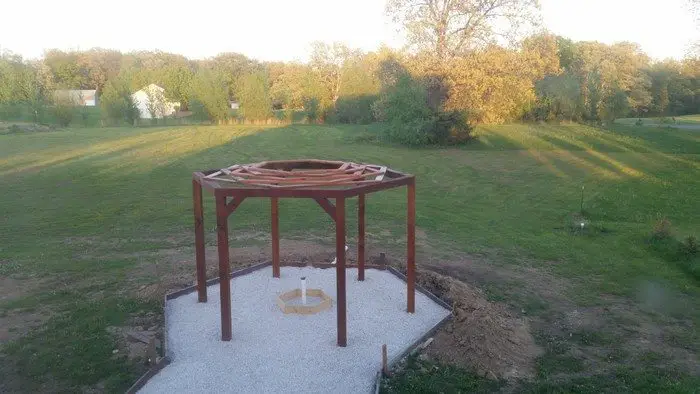
Regular Inspections and Maintenance
Regularly inspect the structure for cracks, rust, loose bolts, and signs of wear. Pay attention to high-stress and heat-exposed areas. Replace any damaged parts promptly and tighten loose fittings. Maintenance such as applying sealant and rust protector extends the swing’s lifespan and safety.
Ground Anchoring and Support
Securely anchor the swing to the ground with deep concrete foundations or heavy-duty ground anchors suitable for the soil. Ensure the design can support the hexagon’s weight and user load, with the option to add cross-bracing for extra stability.
Weight Limit and Usage Guidelines
Define and communicate the weight limit for the swing. This includes the number of users it can safely hold at one time. Clear usage guidelines help prevent overloading, which can lead to structural failure.
Safe Seating Arrangements
Creating safe seating arrangements is critical to designing a hexagonal fire pit swing. It’s essential to ensure that the seating offers comfort and adheres to strict safety standards. Here’s how to achieve this:
Secure Attachment of Seats
Securely fasten seats to swing frame using heavy-duty bolts and brackets suitable for wood or metal materials. Seats should not wobble or shift during use, regular checks and tightening of fittings are essential for safety.
Weight Support and Distribution
The hexagonal fire pit swing seats need to be designed with strong materials and construction to evenly support users’ weight without bending or breaking. Reinforce key areas like the seat base and backrest for durability.
Comfortable and Ergonomic Design
While focusing on the structural integrity of the hexagonal fire pit swing, don’t overlook comfort. Seats should have an ergonomic design that supports good posture. Cushions or padding can be added for extra comfort, but ensure they are made of fire-retardant materials. The height and depth of the seats should accommodate users of various sizes.
Smooth Edges and Safe Materials
All seating, especially the swing, should have smooth edges and finishes to prevent scratches or injuries. Opt for materials that are splinter-free and properly treated.
Regular Maintenance Checks
Regularly check hexagonal fire pit swing seats for wear, damage, or loose parts. Pay attention to areas near the fire for faster weakening. Replace or repair damaged parts promptly for safety.
Protective Barriers
Incorporating protective barriers is an essential safety feature for any outdoor entertainment projects. These barriers serve as a safeguard against potential accidents. Here’s how to effectively integrate them:
Design and Placement of Barriers
Ensure the barriers around it are safe and visually appealing, positioned to prevent falls without obstructing the view or access. They should create a clear boundary between the seating and the fire pit.

Heat-Resistant Materials
Materials for the hexagonal fire pit barrier must be heat-resistant to maintain effectiveness despite prolonged exposure to high temperatures. Options include tempered glass, heat-resistant metals, and specially treated wood.
Stability and Durability
Make sure the barriers around the hexagonal fire pit swing are stable, anchored securely, and can withstand heat and pressure from users. Ensure they are robust and firmly attached to the ground or swing structure.
Visibility and Accessibility
While safety is the primary concern, the barriers should not impede visibility or accessibility. Choose materials and designs that allow users to enjoy the warmth and view of the fire pit while seated on the swing. Additionally, ensure that the barriers do not block easy access to and from the seating area.
Regular Safety Checks
Regular inspections are vital to maintain the safety and integrity of the protective barriers around the hexagonal fire pit swing. Check for any signs of damage, weakness, or wear and tear, especially after extreme weather conditions. Promptly repair or replace any compromised parts of the barrier.
Child and Pet Safety
Ensuring the safety of children and pets in the vicinity of a hexagonal fire pit swing is crucial. Here are ways to enhance their safety:
Installation of Gates or Guards
Install gates or guards around the hexagonal fire pit swing to protect children and pets. Choose barriers that are high and sturdy, with designs difficult for kids to open but easy for adults in emergencies.
Fire Safety Education for Children
Teach kids fire safety, and stress the importance of keeping a distance when near fire. Use kid-friendly language and demos to show risks. Remind regularly, especially before using a hexagonal fire pit swing.
Close Supervision
Always supervise children and pets near the hexagonal fire pit swing, especially when the fire is lit. Never leave them unattended, even for a short period. Close supervision can prevent accidental falls or injuries from occurring.
Safe Play Zone
Create a designated play area away from it. This area should be clearly defined and attractive to children so they prefer to stay there. Include toys, play equipment, or anything else that can keep them engaged and away from the fire pit.
Training Pets
Train pets to avoid the hexagonal fire pit swing during gatherings by using barriers or commands. Consistent training is key to keeping pets safe in this area.
Emergency Plan
An effective emergency plan is crucial for safety at the hexagonal fire pit swing. Clear evacuation routes should be marked and regularly checked. Communicate the plan to all users and display it visibly. Keep emergency contact numbers near the swing for easy access.
Lighting and Visibility
Good lighting is essential for safely using swings around a fire pit at night. Enhance lighting by installing bright ambient lights that illuminate the area without being harsh. Place lights strategically around the hexagonal fire pit swing to prevent accidents.
Use LED lights for efficiency and solar-powered options for sustainability. Add motion sensor lights for safety and emergency lighting for power outages.
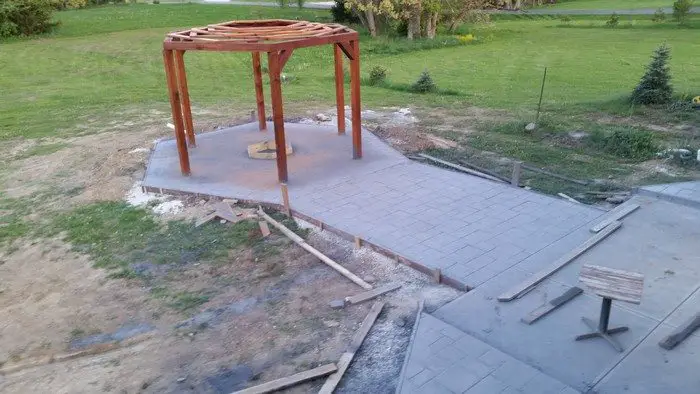
Weather Considerations
Weather conditions impact fire pit and swing safety. Precautions include monitoring wind, clearing debris, and weatherproofing the swing. Safety measures ensure enjoyment with peace of mind and long-lasting well-being.
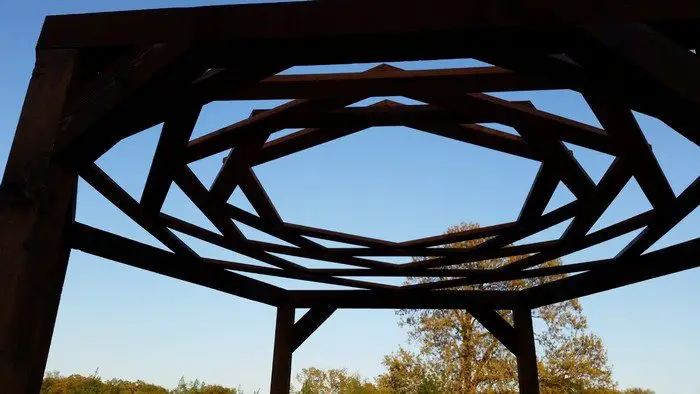
How to Choose the Perfect Site for Hexagonal Fire Pit Swing
Creating a cozy hexagonal fire pit swing involves more than just the swing and the fire pit. The location is key. Here’s how to pick a spot that combines both functionality and safety:
Consider the Size and Level of the Area
- Space Requirements: Ensure you have a space that’s at least 5 feet larger than your proposed structure on all sides. This usually translates to a minimum area of 25 feet across, providing ample room for both the swing and safe fire management.
- Terrain Leveling: While your starting point doesn’t need to be perfectly flat, plan to level the ground after erecting your structure. Pre-leveling might lead to unnecessary additional work like digging deeper holes for support posts.
Think About Usage and Accessibility
- Multi-seasonal Use: Select a location where the fire pit can be enjoyed throughout the year. Consider how frequently it will be used with or without a fire, as a gathering spot for family and friends.
- Shade Availability: Ideally, choose a site that offers natural shade for comfort during warmer months. If you have trees nearby, ensure branches are not directly over the fire pit for safety reasons.
Emphasize Safety Features
- Overhead Clearance: Avoid areas with overhanging branches to minimize fire hazards. Having clear sky above your fire pit reduces risks and allows heat and smoke to dissipate safely.
By thoughtfully considering these factors—space, leveling, seasonal usage, and safety—you’ll ensure your porch-swing fire pit is both an inviting and secure addition to your outdoor space.
Conclusion
Building a hexagonal fire pit swing is a fulfilling project that adds a unique charm to any outdoor space. By following the detailed steps and considering the provided safety tips, you can create a cozy, inviting area for relaxation and social gatherings.
Regular maintenance and adherence to safety guidelines ensure that your fire pit swing remains a safe and enjoyable feature for years to come.





